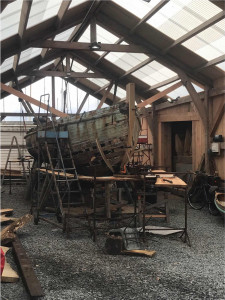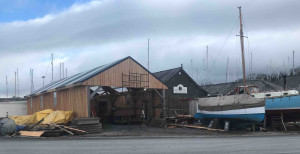By Mike Smylie
IMAGINE A FLEET OF SMALL EX-FISHING BOATS TRADING BY SAIL AROUND THE PORTS OF WALES, BRINGING IN GOODS FROM NORTHERN FRANCE & THE IBERIAN PENINSULA…
That sounds like a dream but dreams have a habit of turning into reality and the first steps to achieving this goal have already started.
Elwy Working Woods, in conjunction with Waterfront Marine, has begun the restoration of MYSTERY II. Last year they built the timber-framed shed over the boat and now she’s housed away from the weather whilst Scott and his team at Waterfront Marine – mostly Joe, that is – work on repairs.
During a recen t visit, Joe explained how he was approaching the job by establishing the shape and ensuring it doesn’t sag before working on the centreline. By then the stem had been renewed with a laminated replacement, along with the deadwood and the after end of the elm keel. Some frames and floors have also been replaced though some of the middle section floors he will retain. Much more reframing will follow, as well as re-timbering the after part of the stern.
t visit, Joe explained how he was approaching the job by establishing the shape and ensuring it doesn’t sag before working on the centreline. By then the stem had been renewed with a laminated replacement, along with the deadwood and the after end of the elm keel. Some frames and floors have also been replaced though some of the middle section floors he will retain. Much more reframing will follow, as well as re-timbering the after part of the stern.
The larch planking sits up at Elwy Working Woods, above Abergele, where all the timber for the shed had been cut and machined. Adrian Farey who owns the business has built a superb site over the last 30 years, and had just installed a new Wood-Mizer saw in his bottom shed. Up the track is his fully equipped workshop from where he can run courses and/or prepare his larch and/or Douglas fir for timber framing.
As in most historic vessel restorations, it’s the cost that limits the work. Funding from national sources is seldom available but that doesn’t put Adrian off. He’s started the project and wants others to join in the adventure. And what an adventure it will be, sailing the fleet back and forth, bringing in French goods and taking British produce back to the continent. So, for all those interested in sustainable cargo, he is selling shares in MYSTERY II. 
In order to finance the project which is estimated to be £200,000, he is adopting the traditional practice of selling 64 shares which will be priced at £3000, half shares at £1500 and quarter shares at £750. Although no dividends will be paid, certainly to start with anyway, the profit will be the sense of achievement from being part of an imaginative regeneration project that will breathe life into our coastal communities, will involve young people from all walks of life learning seamanship and will demonstrate the sense and harmony of carrying goods by sailing boat. Shareholders will receive samples of all the goods carried and will be invited to sailing days on the Menai Straits. They will also be encouraged to take part in the project in whatever way they feel appropriate: volunteering with tasks such as painting, oiling and varnishing; marketing and publicity; or organising crew and cargoes to and from Irish Sea and Channel ports.
 Although he regards this project being what he terms a ‘pilot’ project so that he can explore opportunities, relationships and destinations for further, maybe larger, vessels to be added to the fleet of vessels, he does already have a track record. In the summer of 2022 he chartered Scott Metcalfe’s KLEVIA to sail to Brittany where, with a crew of 10 young people from North Wales, he loaded and brought back 500kgs of onions and 400 bottles of cider. KLEVIA, readers might recall from the previous issue, was chartered by New Dawn Traders, also in summer 2022, to sail to Portugal to bring back wine. This year KLEVIA will again, in August 2023, sail back to France to bring back onions and cider, and maybe other goods such as chocolate.
Although he regards this project being what he terms a ‘pilot’ project so that he can explore opportunities, relationships and destinations for further, maybe larger, vessels to be added to the fleet of vessels, he does already have a track record. In the summer of 2022 he chartered Scott Metcalfe’s KLEVIA to sail to Brittany where, with a crew of 10 young people from North Wales, he loaded and brought back 500kgs of onions and 400 bottles of cider. KLEVIA, readers might recall from the previous issue, was chartered by New Dawn Traders, also in summer 2022, to sail to Portugal to bring back wine. This year KLEVIA will again, in August 2023, sail back to France to bring back onions and cider, and maybe other goods such as chocolate.
Again places are available at a cost. Contact Adrian Farey: ade.farey@gmail.com ~ 01745 833742 ~ 07833097754
The fleet of boats already exists: alongside KLEVIA is Scott Metcalfe’s other vessel, the ex-Danish fishing kotter VILMA, and Adrian’s own Morecambe Bay nobby LASSIE. So, the roots are in place.
Growth, given the right nurturing, is inevitable!
What I like best of the whole project, apart from breathing life back into an old boat, is the sense of community around these old Welsh harbours. Indeed, once their very backbone relied upon trading by sea, whether it be the export of slate and coal, or simply seaman who crewed vessels all over the oceans, often returning just for the short herring fishery. But much more, and goods came in to sustain the coastal communities.
Now the maritime tradition has long gone but here we have a chance of bringing it back to life. And, once other communities see what is possible – some already are when they see the likes of New Dawn Traders – then others will follow. I’d love to see all those restored boats working trade rather than acting as charter vessels, simply relying upon those that can afford to holiday afloat. Why not combine the two things and let the paying guests sample trade? They might even gain more! It has been done and now there’s a chance to multiply successes in this field. 
So I suggest a conversation which might lead to a more realistic approach to trade. Do we really want ocean-going container ships bringing in commodities from the other side of the world? Our government is keen to do their pathetic deals with far off countries in exchange for trading with our nearest neighbours. But this is only to attempt to show that Brexit is working, whereas we all know it isn’t! Do we want lamb from New Zealand when we’ve great Welsh lamb here? Do we need vegetables from thousands of miles away when we can grow them here? Do we want fake wooden furniture from China when we have great supplies of timber here? No. We have been trading around the world for millennia but always to the nearest supply. Spices from the east because we never had them. But, come on, trade status with Australia to replace that with France? You must be joking! 
So I can only hint at the opportunity that this project will bring. Only you know your abilities to get involved. I can only recommend what I see as a safe investment in terms of helping the planet.
MYSTERY II history update.
Designed by William Stoba, famous for his fast nobbies, MYSTERY II was built by James Armour and launched in 1911 for Frank Hughes of Wallasey as a gaff-rigged trawler. Registered as LL59, she fished from the Mersey up to the beginning of the Second World War and afterwards went to Conwy, ceasing fishing in 1991. For over fifty years she was owned by Norman ‘Spike’ Brown.
 It seems that in 2017 she was taken from what was almost her watery grave on the banks of the river Mersey where she was threatened with demolition to the workshops of the Liverpool Community College, thanks to the Nobby Owners Association. And there she stayed until 2022 at which time, especially after the pandemic, they realised they simply did not have the means to restore here. She was then moved to Port Penhryn.
It seems that in 2017 she was taken from what was almost her watery grave on the banks of the river Mersey where she was threatened with demolition to the workshops of the Liverpool Community College, thanks to the Nobby Owners Association. And there she stayed until 2022 at which time, especially after the pandemic, they realised they simply did not have the means to restore here. She was then moved to Port Penhryn.
What is clear is that she kept up Stoba’s reputation as she was a fast nobby. In her first year she won a Sailing Club Regatta and, in 1990, she kept up that reputation, coming in second in the Liverpool Nobby race, using a suit of borrowed sails.
Contact Adrian Farey: ade.farey@gmail.com ~ 01745 833742 ~ 07833097754 for crewing, buying shares or just being part of this wonderful project.


